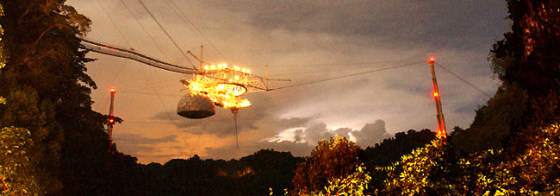I was doing my best to stay awake while the Arecibo shuttle nosed its way into the dark, bumpy hills south of the city. My driver was silent, intent on dodging the homeless dogs and feral cats that line the road. Eventually, the night sky was broken by the red lights of the telescope towers, poking above the rump of a hill.
I stepped out of the van into a wall of humid air. Below me, barely discernable amid the shadowy vegetation, hulked the telescope dish. Here, 18 acres of aluminum mesh sprawl across the landscape, silently collecting radio noise from the distant depths of the universe. This is the big one, the alpha male of telescopes; the largest single antenna on the planet.
Large, however, is a relative term. If Earth were squeezed and shrunk to fit onto a football field, Arecibo’s mammoth reflector would be a pinhead stuck onto its surface. And if the solar system were scaled so that Pluto’s orbit was within that field, Earth itself would be less than a pinhead.
Face it. As big as this telescope is, it only intercepts a minute fraction of the radio waves that pound through the dark spaces of the galaxy. Fortunately, it’s got first-rate electronics. If as much as 0.00000000000000000001 watts of radio energy wafts onto the dish, our receivers light up.

What does this mean for SETI? What sort of transmitting setup could this instrument detect?
Imagine an alien civilization a thousand light-years away. Imagine further that these cosmopolitan beings have constructed a clear-channel radio station that broadcasts in all directions equally. Their signal blankets the universe. Some of that signal could fall onto Arecibo’s 1,000-foot reflector. If so, it would be detectable only if the transmitter power exceeds … 100 trillion watts!
That’s a lot of power. In fact, that’s 10 times more power than the total energy consumption of modern Homo sapiens. Ten times the energy use of 6 billion gas-guzzling, kilowatt-consuming souls.
Of course, the aliens might just have that kind of power at their disposal; it’s not inconceivable. However, Barney Oliver, one of the brightest minds ever to consider the premises of SETI, was skeptical whether even sophisticated extraterrestrials could ever engineer such high-powered radio sets. His concise pronouncement on this possibility was to note that "waveguides melt." Maybe the aliens can muster the energy, but don’t build such beefy transmitters because their hardware can’t handle the juice.
Fortunately for both waveguide fabricators and SETI practitioners, knowledge is power. Or rather, knowledge can be traded for power. Aliens with good astronomy departments and a yen to get in touch will have enough information to target their broadcasts. They’ll know which stars have habitable planets, for instance. They may have long, long lists of such stars. So they don’t need to transmit indiscriminately, but can pinpoint their recipients. And save on the energy bill.
It’s the difference between washing an entire city with a TV signal from a hilltop antenna, and sending that same signal to individual households with a cable. The latter is much more energy-efficient.
Indeed, if the aliens have really accurate information about the distances and motions of stars — the kind our astronomers might have in a hundred years — they can direct their broadcasts to cover just the inner solar systems of likely targets. In that case, their transmitters would only need about 1 watt of power to be detectable by Arecibo. That’s approximately the power of a flashlight.
It takes about 20 minutes to walk around the telescope’s perimeter, sufficient time to be impressed with its dimensions. There’s a slight drizzle in the air, wetting the path and coating my face. I stop to squint at the perforated aluminum panels of the reflector and wonder if right now, a pinging beacon from some distant society is falling unseen on that broad metal expanse. A calling card sent our way in the hope that this star may have an interesting world. The numbers, at least, are favorable.
